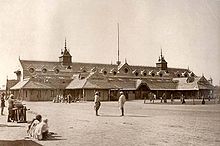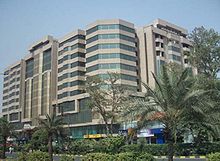|
|
|
| |
| |
| |
 |
About Lahore |
|
|
| |
| Lahore is the capital of the Pakistani province of Punjab and is the second largest city in Pakistan after Karachi. It is popularly known as the Heart of Pakistan, due to its historical importance in the creation of Pakistan, and also being a cultural, political and educational centre of the country. It is also often called the Gardens of the Mughals or the City of Gardens because of the heritage of the Mughal Empire. It is located near the Ravi River and Wagah, close to the Pakistan-India border. Much of Lahore's architecture from the Mughal and colonial eras has been preserved. Mughal structures such as the Badshahi Mosque, Lahore Fort, Shalimar Gardens and the mausoleums of Jehangir and Nur Jehan are popular tourist spots in the city. Colonial British structures such as the Lahore High Court, General Post Office (GPO) and many of the older universities still retain their Mughal-Gothic style. Punjabi is the native language of the province and is the most widely-spoken language in Lahore and rural areas. Urdu and English, however, are becoming more popular with younger generations since they are officially supported, whereas Punjabi has no official patronage. Many people of Lahore who speak Punjabi are known as Lahori Punjabi due to their use of a mixture of Punjabi and colloquial Urdu. According to the 1998 census, Lahore's population was nearly 7 million. Mid-2006 government estimates now put the population at approximately 10 million. This makes Lahore the fifth largest city in South Asia and the 23rd largest city in the world. |
.jpg) |
|
| |
History
Ptolemy, the celebrated astronomer and geographer, mentions in his Geographia a city called Labokla[3] situated on the route between the Indus River and Palibothra, or Pataliputra (Patna), in a tract of country called Kasperia (Kashmir), described as extending along the rivers Bidastes or Vitasta (Jhelum), Sandabal or Chandra Bhaga (Chenab), and Adris or Iravati (Ravi). This city may be ancient Lahore.[citation needed] Another legend, based on oral traditions, states that Lahore was named after Lava, son of the Hindu god Rama, who supposedly founded the city. To this day, the Lahore Fort has a vacant temple dedicated to Lava (also pronounced Loh, hence "Loh-awar" or The Fort of Loh). Likewise, the Ravi River that flows through northern Lahore was named for the Hindu goddess Durga. The oldest authentic document about Lahore was written anonymously in 982 and is called Hudud-i-Alam.
It was translated into English by Vladimir Fedorovich Minorsky and published in Lahore in 1927. In this document, Lahore is referred to as a small shahr (city) with "impressive temples, large markets and huge orchards." It refers to "two major markets around which dwellings exist," and it also mentions "the mud walls that enclose these two dwellings to make it one." The original document is currently held in the British Museum. Lahore was called by different names in history, and to date there is no evidence to suggest the actual time, when the city was made, some historians trace the history of the city as far as 4000 years ago. |
 |
|
| |
Geography and Climate
Lying between 31°15' and 31°45' North latitude and 74°01' and 74°39' East longitude, Lahore is bounded on the north and west by the Sheikhupura District, on the east by Wagah, and on the south by Kasur District. The Ravi River flows on the northern side of Lahore. Lahore city covers a total land area of 404 km² and is still growing. The weather of Lahore is extreme during the months of May, June, and July, when the temperatures soar to 40-45 °C. In August, the monsoon seasons starts, with heavy rainfall throughout the province. December, January, and February are the coldest months, when temperatures can drop to -1 °C.[citation needed] The city's highest maximum temperature was 48.3°C, recorded on June 6, 1921, and again on June 9, 2007. At the time the meteorological office recorded this official temperature in the shade, it reported a heat index in direct sunlight of 55 °C, lowest temperature recorded is -2.2°C. |
 |
| |
|
Lahore's culture is unique. Known as the cultural capital or Heart of Pakistan, the city has been the seat of the Mughal Empire and the Sikh Empire as well as the capital of Punjab in Mahmud Ghaznavi's 11th century empire and in the British Empire. Lahore played an important role in Pakistani history, as it was in this city where the independence declaration for Pakistan was made. The city was the only known major city of the British Empire that would come into the new Muslims state.[citation needed] It was the largest city in the newly formed Pakistan at the time of independence and provided the easiest access to India, with its porous border near the Indian city of Amritsar only 30 miles (48 km) to the east. Large numbers of Hindus, Sikhs, and Muslims lived closely in Lahore in the pre-Partition era, and the city suffered many revolts and demonstrations, as well as bloodshed and mobs, at the time of independence.[citation needed] Lahore was also wanted by the Sikhs since it used to be their capital before the British. Initially, Lahore was planned to be made the capital of the newly-formed Pakistan, but the idea was dropped due to the city's close proximity to India; Karachi was chosen instead.[citation needed] Lahore's culture -- its history, institutions, food, clothing, films, music, fashion, and liberal community lifestyle -- attract people from all over the country. Kites for sale on the streets of Lahore on the eve of the Basant festivalLahore is an extremely festive city. The people of Lahore celebrate many festivals and events throughout the year, blending Mughal, Western, and current trends. Eid ul-Fitr and Eid ul-Adha are celebrated. Many people decorate their houses and light candles to illuminate the streets and houses; roads and businesses are lit for days during these public holidays.[citation needed] {Basant is a Punjabi festival marking the coming of spring. Basant celebrations in Pakistan are centered in Lahore, and people from all over the country as well as abroad come to the city for the annual festivities. Kite-flying competitions traditionally take place on city rooftops during Basant. Courts have banned the kite-flying because of casualties and power installation losses. The ban was lifted for two days in 2007, then immediately reimposed when 11 people were killed by celebratory gunfire, sharpened kite-strings, electrocution, and falls related to the competition. The Festival of Lamps, or Mela Chiraghan, is an important and popular event in Lahore. This is celebrated at the same time as Basant, every spring on the last Friday of March, outside the Shalimar Gardens. The National Horse and Cattle Show is one of the most famous annual festivals, held in spring in the Fortress Stadium. The week-long activities include a livestock display, horse and camel dances, tent pegging, colourful folk dances from all regions of Pakistan, mass-band displays, and tattoo shows in the evenings. On August 14, the people of Pakistan celebrate the day Pakistan gained its independence from the British Raj. There are lots of celebrations in Lahore, the streets are full of people singing and dancing. Parades of the Pakistan Army and Pakistan Air Force are held early in the morning. Concerts are held with many pop and classical singers. The World Performing Arts Festival is held every autumn (usually in November) at the Alhambra cultural complex, a large venue consisting of several theatres and amphitheatres. This ten-day festival consists of musicals, theatre, concerts, dance, solo, mime, and puppetry shows. The festival has an international character with nearly 80 percent of the shows performed by international performers. On average 15-20 different shows are performed every day of the festival.
Lahore's culture is unique. Known as the cultural capital or Heart of Pakistan, the city has been the seat of the Mughal Empire and the Sikh Empire as well as the capital of Punjab in Mahmud Ghaznavi's 11th century empire and in the British Empire. Lahore played an important role in Pakistani history, as it was in this city where the independence declaration for Pakistan was made. The city was the only known major city of the British Empire that would come into the new Muslims state.[citation needed] It was the largest city in the newly formed Pakistan at the time of independence and provided the easiest access to India, with its porous border near the Indian city of Amritsar only 30 miles (48 km) to the east. Large numbers of Hindus, Sikhs, and Muslims lived closely in Lahore in the pre-Partition era, and the city suffered many revolts and demonstrations, as well as bloodshed and mobs, at the time of independence.[citation needed] Lahore was also wanted by the Sikhs since it used to be their capital before the British. Initially, Lahore was planned to be made the capital of the newly-formed Pakistan, but the idea was dropped due to the city's close proximity to India; Karachi was chosen instead.[citation needed] Lahore's culture -- its history, institutions, food, clothing, films, music, fashion, and liberal community lifestyle -- attract people from all over the country. Kites for sale on the streets of Lahore on the eve of the Basant festivalLahore is an extremely festive city. The people of Lahore celebrate many festivals and events throughout the year, blending Mughal, Western, and current trends. Eid ul-Fitr and Eid ul-Adha are celebrated. Many people decorate their houses and light candles to illuminate the streets and houses; roads and businesses are lit for days during these public holidays.[citation needed] {Basant is a Punjabi festival marking the coming of spring. Basant celebrations in Pakistan are centered in Lahore, and people from all over the country as well as abroad come to the city for the annual festivities. Kite-flying competitions traditionally take place on city rooftops during Basant. Courts have banned the kite-flying because of casualties and power installation losses. The ban was lifted for two days in 2007, then immediately reimposed when 11 people were killed by celebratory gunfire, sharpened kite-strings, electrocution, and falls related to the competition. The Festival of Lamps, or Mela Chiraghan, is an important and popular event in Lahore. This is celebrated at the same time as Basant, every spring on the last Friday of March, outside the Shalimar Gardens. The National Horse and Cattle Show is one of the most famous annual festivals, held in spring in the Fortress Stadium. The week-long activities include a livestock display, horse and camel dances, tent pegging, colourful folk dances from all regions of Pakistan, mass-band displays, and tattoo shows in the evenings. On August 14, the people of Pakistan celebrate the day Pakistan gained its independence from the British Raj. There are lots of celebrations in Lahore, the streets are full of people singing and dancing. Parades of the Pakistan Army and Pakistan Air Force are held early in the morning. Concerts are held with many pop and classical singers. The World Performing Arts Festival is held every autumn (usually in November) at the Alhambra cultural complex, a large venue consisting of several theatres and amphitheatres. This ten-day festival consists of musicals, theatre, concerts, dance, solo, mime, and puppetry shows. The festival has an international character with nearly 80 percent of the shows performed by international performers. On average 15-20 different shows are performed every day of the festival. |
|
|
| |
|
| |
|
|
|
|
|
|
|
| |
|